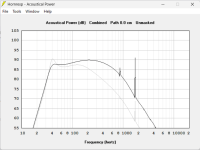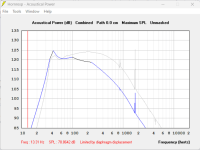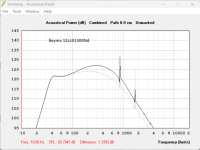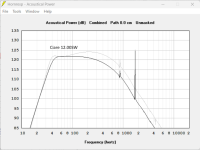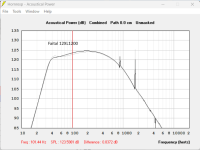Indeed it is a compromise to look at.The car audio type drivers with more Xmax may have more LF (given more power), but probably won't perform as well up top with the heavy MMS and inductance losses. I'd be more concerned about Pmax up high than
Mind you, this driver has more motor force, and in the upper range of the bass, all drivers are more efficient and having less lifting to do in the first place. I would look into losing the top 5Hz in order to reach the goal down there if it is necessary. The sims don't show me that the car woofer would win at first glance, but surprisingly it doesn't show it would exactly lose. With 12TBX100 design I had, I would go right for car audio driver, this Faital driver is great and holds up
I ran the Eton MW12 through Hornresp, with interesting results: there isn't actually much difference in available SPL with the Faital 12RS1066 or the Eton driver, when driven from the Powersoft T602 amplifier.
First up, compare the voltage sensitivity - first image. This is with 2V into each driver, so the Eton MW12 is receiving 1w (2x 2ohm coils in series) while the Faital (8ohm) is around 0.5w. The voltage sensitivity matches, but the Eton is receiving more current.
Next, I used the following to compare them on Max.SPL on Hornresp:
This draws a graph of the absolute loudest that driver+cabinet can go, within the constraints above. It's not the usual frequency response shape, because different limitations apply (excursion, amplifier voltage, driver power) apply at different frequencies.
On the 2nd image, the Faital is the grey line while the blue/black is the Eton.
Things to note: Below PR tuning, the Faital runs out of excursion quite quickly. There's also a small excursion-limited notch around 55Hz. Elsewhere, we're limited by the amplifier's output voltage. I'm not especially worried about the 55Hz - a couple of mm past Xmax would be fine.
The Eton is different. I included the red cursor to show that the Eton only runs into any kind of excursion problem below 15Hz. It could be run with a 20Hz HPF and be completely safe from mechanical destruction from the Powersoft amp. It will, however, have some thermal difficulties: around 40Hz, the maximum output is limited by the 1800w that we've allowed the driver to receive. NB - Eton suggest a mere 1200w "music power".
Playing around further, I notice this: in order to force the Eton to use all of its (extremely large) Xmax, you have to either use a really silly cabinet (200L tuned to 10Hz) or grossly exceed the rated input power.
If they re-did those Eton drivers with half the Xmax and the ability to use all of that excursion at sensible power inputs, they'd be on to a winner. As they are, though, there's a lot of wasted potential.
It's been interesting to simulate the two drivers side-by-side, but the 8ohm impedance, sensitivity advantage and better thermal power handling has me leaning towards the Faital driver so far.
Next steps: investigate the offerings from B&C, Beyma, 18Sound, etc and see if they have anything that'll clearly beat the Faital 12RS1066.
Chris
First up, compare the voltage sensitivity - first image. This is with 2V into each driver, so the Eton MW12 is receiving 1w (2x 2ohm coils in series) while the Faital (8ohm) is around 0.5w. The voltage sensitivity matches, but the Eton is receiving more current.
Next, I used the following to compare them on Max.SPL on Hornresp:
- Amplifier maximum output = 103V, which is the rated 1300w/ch@8ohm.
- Driver maximum input power = 2x RMS power. 2000w for the Faital, 1800w for the Eton
- Driver maximum excursion = rated Xmax. Faital = 12.5mm, Eton = 48mm!!
This draws a graph of the absolute loudest that driver+cabinet can go, within the constraints above. It's not the usual frequency response shape, because different limitations apply (excursion, amplifier voltage, driver power) apply at different frequencies.
On the 2nd image, the Faital is the grey line while the blue/black is the Eton.
Things to note: Below PR tuning, the Faital runs out of excursion quite quickly. There's also a small excursion-limited notch around 55Hz. Elsewhere, we're limited by the amplifier's output voltage. I'm not especially worried about the 55Hz - a couple of mm past Xmax would be fine.
The Eton is different. I included the red cursor to show that the Eton only runs into any kind of excursion problem below 15Hz. It could be run with a 20Hz HPF and be completely safe from mechanical destruction from the Powersoft amp. It will, however, have some thermal difficulties: around 40Hz, the maximum output is limited by the 1800w that we've allowed the driver to receive. NB - Eton suggest a mere 1200w "music power".
Playing around further, I notice this: in order to force the Eton to use all of its (extremely large) Xmax, you have to either use a really silly cabinet (200L tuned to 10Hz) or grossly exceed the rated input power.
If they re-did those Eton drivers with half the Xmax and the ability to use all of that excursion at sensible power inputs, they'd be on to a winner. As they are, though, there's a lot of wasted potential.
It's been interesting to simulate the two drivers side-by-side, but the 8ohm impedance, sensitivity advantage and better thermal power handling has me leaning towards the Faital driver so far.
Next steps: investigate the offerings from B&C, Beyma, 18Sound, etc and see if they have anything that'll clearly beat the Faital 12RS1066.
Chris
Attachments
Great exercise!
Though I think that given the design, sizing, looks and price, the 48mm of Xmax is P-P
So real Xmax is 24mm. That doesn't mean better drivers don't exist. This was just firstand quite cheap shot at it.
Though I think that given the design, sizing, looks and price, the 48mm of Xmax is P-P
So real Xmax is 24mm. That doesn't mean better drivers don't exist. This was just firstand quite cheap shot at it.
I did wonder if 48mm one-way was too good to be true.
Even so, putting the Eton MW12 into the 28L-40Hz box and hitting it with 103Vrms (somewhere around 2.5KW@4ohm), it still only reaches 14mm of one-way excursion around 50Hz. ie, it'll burn up before it ever reaches Xmax.
It's a strange driver: the T/S parameters are great for small boxes, but it'll never get close to its excursion-potential that way.
I suspect that with careful management of the long-term power being delivered, it'd be possible to make use of the Eton's excursion. You'd need an amplifier capable of 170Vrms output, which equates to around 7KW into the nominal 4ohm impedance, to get it to 24mm of one-way excursion. The result is >125dB, and 2x PRs would each be undergoing >60mm one-way excursion. ie, 6x PRs required to keep it to ~20mm.
Of course, that's only ever useful as peak output - as soon as something sustained comes along, output will be reduced dramatically as the power input has to be reduced.
For now, I'm going to see what the other driver manufacturers have on offer.
Chris
Even so, putting the Eton MW12 into the 28L-40Hz box and hitting it with 103Vrms (somewhere around 2.5KW@4ohm), it still only reaches 14mm of one-way excursion around 50Hz. ie, it'll burn up before it ever reaches Xmax.
It's a strange driver: the T/S parameters are great for small boxes, but it'll never get close to its excursion-potential that way.
I suspect that with careful management of the long-term power being delivered, it'd be possible to make use of the Eton's excursion. You'd need an amplifier capable of 170Vrms output, which equates to around 7KW into the nominal 4ohm impedance, to get it to 24mm of one-way excursion. The result is >125dB, and 2x PRs would each be undergoing >60mm one-way excursion. ie, 6x PRs required to keep it to ~20mm.
Of course, that's only ever useful as peak output - as soon as something sustained comes along, output will be reduced dramatically as the power input has to be reduced.
For now, I'm going to see what the other driver manufacturers have on offer.
Chris
Some comparisons attached. In all cases, the grey trace is the Faital 12RS1066.
I went through a couple of websites and entered drivers I've heard of, and/or ones which looked like they'd do something interesting. I set the power input to match the T602: 1300/2500/3000w/ch into 8/4/2ohm. I'd prefer 8ohm (nominal) drivers, since it's easy to add more in parallel in a PA situation.
In order, the B&C 12FG100 has a slightly-flatter response than the 12RS1066, but the B&C rolls off slightly earlier. A reasonable alternative, but certainly not any better.
The Beyma 12LEX1300Nd is almost identical, but the Beyma has around 10% more radiating area, so uses less excursion. Rated Xmax is around 10% lower, though. 30% higher power handling than the 12RS1066.
The BMS 12N630 clearly doesn't have enough motor force for a box this small, resulting in a peak above the tuning frequency. NB - it's way past Xmax in the highlighted area.
The Ciare 12.00SW isn't bad, but loses out to the 12RS1066.
Ciare CSW7112EVO is interesting. It has 2x 1ohm voicecoils, so I simulated those in series for a 2ohm nominal load. When you EQ the 40Hz peak down a bit, the actual power input is surprisingly low across most of the range. With a 22mm Xmax, it has a lot of output potential, but (like the Eton driver in the previous post) doesn't make use of that in this cabinet. A larger cabinet tuned lower would be interesting.
The Faital 12XL1200 has slightly more cone area, equal excursion, and 40% higher power handling than the 12RS1066. There are small differences in the frequency response chart, but not enough to be concerned about IMO. It's possible that the higher power handling will mean less power compression.
If I was choosing from scratch, I'd probably go with either the Beyma 12LEX1300Nd, or the Faital 12XL1200. Both have more power handling than the 12RS1066, but neither offers significantly more displacement.
For now, I'm going to proceed with the Faital 12RS1066 drivers I have here, and order a pair of 12" PRs.
Once the prototype is built, I'll find a suitable venue for testing against my current 18" subs. I might also see about renting an industry-standard 1x18" sub, to see how things stack up.
Chris
I went through a couple of websites and entered drivers I've heard of, and/or ones which looked like they'd do something interesting. I set the power input to match the T602: 1300/2500/3000w/ch into 8/4/2ohm. I'd prefer 8ohm (nominal) drivers, since it's easy to add more in parallel in a PA situation.
In order, the B&C 12FG100 has a slightly-flatter response than the 12RS1066, but the B&C rolls off slightly earlier. A reasonable alternative, but certainly not any better.
The Beyma 12LEX1300Nd is almost identical, but the Beyma has around 10% more radiating area, so uses less excursion. Rated Xmax is around 10% lower, though. 30% higher power handling than the 12RS1066.
The BMS 12N630 clearly doesn't have enough motor force for a box this small, resulting in a peak above the tuning frequency. NB - it's way past Xmax in the highlighted area.
The Ciare 12.00SW isn't bad, but loses out to the 12RS1066.
Ciare CSW7112EVO is interesting. It has 2x 1ohm voicecoils, so I simulated those in series for a 2ohm nominal load. When you EQ the 40Hz peak down a bit, the actual power input is surprisingly low across most of the range. With a 22mm Xmax, it has a lot of output potential, but (like the Eton driver in the previous post) doesn't make use of that in this cabinet. A larger cabinet tuned lower would be interesting.
The Faital 12XL1200 has slightly more cone area, equal excursion, and 40% higher power handling than the 12RS1066. There are small differences in the frequency response chart, but not enough to be concerned about IMO. It's possible that the higher power handling will mean less power compression.
If I was choosing from scratch, I'd probably go with either the Beyma 12LEX1300Nd, or the Faital 12XL1200. Both have more power handling than the 12RS1066, but neither offers significantly more displacement.
For now, I'm going to proceed with the Faital 12RS1066 drivers I have here, and order a pair of 12" PRs.
Once the prototype is built, I'll find a suitable venue for testing against my current 18" subs. I might also see about renting an industry-standard 1x18" sub, to see how things stack up.
Chris
Attachments
...but if you keep the camera rolling..It's a strange driver: the T/S parameters are great for small boxes, but it'll never get close to its excursion-potential that way.
It is not so much strange as it just doesn't follow the T&S design with particular alignments. Ultimately, SPL is made by air displacement, so if in the given/utilitarian case the driver can employ the displacement, it will do its intended job. I don't believe this driver was made for 28l. It is just that it has enough motor force to drive such volume with usable output. But the volume does not fully exploit the speaker capabilities obviously. And that's not strange at all. The times of response alignments are gone.
Anyways, any gain over the Faital driver will be paid dearly. It is a great driver and going up is an exponential curve. Price wise too.
There is a Youtube video of a B&C Speakers employee, Bennett Prescott, describing TSP. One of the things he mentions is that, everything else being equal, higher BL = higher efficiency. As a by-product, the frequency response is not flat any more. This is no big deal as the subwoofer is meant to be processed by a DSP anyway.
The woofer might not have been designed for such small enclosures, even though these yield a flat frequency response.
The woofer might not have been designed for such small enclosures, even though these yield a flat frequency response.
Last edited:
The whole BP series is awesome watch.
Indeed if there is enough amp and DSP, higher motor force wins. But in reality, there is not always enough amp...
Indeed if there is enough amp and DSP, higher motor force wins. But in reality, there is not always enough amp...
And even if there was, can it handle the heat? Requiring 1000 or more watts of average power going in for a given SPL has far different effects on the driver than requiring only 100. You get more of a % reduction in motor force. Not to mention tuning changes which will upset that nice flat response you have DSP’ed in. At some point you just lose the ability to scale the physical size down and make up for it with power.
Talking about High BL drivers, we are not talking about power, but voltage capabilities. In order to get NORMAL power to high Bl speaker, you need apply high voltage, otherwise the speaker is not powered as well as "conventional" speaker. And what you do is you exactly FLATTEN the response at the same time.
Scaling down and adding power is also a way, but indeed hard way with limits.
Scaling down and adding power is also a way, but indeed hard way with limits.
I suspect that with careful management of the long-term power being delivered, it'd be possible to make use of the Eton's excursion. You'd need an amplifier capable of 170Vrms output, which equates to around 7KW into the nominal 4ohm impedance, to get it to 24mm of one-way excursion
When you lower the Eton's BL by 50%, more voltage would be required.
It may reach 24mm one-way excursion and not exceed power/voltage rating measured open air.
Well, the pair of Dayton PRs are on their way. I suspect I have enough scrap MDF to make a prototype cabinet.
Dayton also makes some PRs which might be suitable for very-compact 2-way speakers tuned in the 60-70Hz range. A subject for another thread, I think.
Chris
Dayton also makes some PRs which might be suitable for very-compact 2-way speakers tuned in the 60-70Hz range. A subject for another thread, I think.
Chris
Don't we always want that fun cute little powerhouse no matter what it is? I could continue down to keychain speaker. Have JBL Xtreme 4, and would like to outdo it, 12" with PRs, looks like next step up. Not sure about step down. Somehow getting that dream accomplished through someone else works, but then the taste for materializing it also grows. Is it in the path to the goal, or in the goal?
Let us know with your progress!
Let us know with your progress!
There's also 4th order bandpass. This topology loads the woofer to net a lower Fs/Fc while providing protection against overexcursion and won't require a PR, which as said before has some significant issues at higher SPL, specifically linearity. A properly designed and tuned 4th order BP can have all the benefits of sealed enclosures with the extra low end extension of ported boxes. The extra air load on the front of the cone can help balance the uneven dynamic forces on the suspension, increasing reliability and lowering HD. Group delay needs to be carefully assessed and optimized depending on signal processing used. 4th order BP doesn't have to be "one note bass" sounding.
Profiguy,
BP4 requires a relatively large port for these drivers - it ends up taking up a lot of cabinet volume. I also had difficulty getting a decent frequency response with the 12RS1066 and similar drivers.
Interestingly, the 18XL1800 used in my sealed subs look pretty promising in a BP4, although not completely excursion-safe - there's an excursion peak at 30Hz.
Chris
BP4 requires a relatively large port for these drivers - it ends up taking up a lot of cabinet volume. I also had difficulty getting a decent frequency response with the 12RS1066 and similar drivers.
Interestingly, the 18XL1800 used in my sealed subs look pretty promising in a BP4, although not completely excursion-safe - there's an excursion peak at 30Hz.
Chris
Don't we always want that fun cute little powerhouse no matter what it is? I could continue down to keychain speaker. Have JBL Xtreme 4, and would like to outdo it, 12" with PRs, looks like next step up. Not sure about step down. Somehow getting that dream accomplished through someone else works, but then the taste for materializing it also grows. Is it in the path to the goal, or in the goal?
Let us know with your progress!
We do!
One of the things I really enjoy about speaker design is building something that sounds way bigger than it actually is.
The Kartesian Sub120vHP is great for this trick, but you'll need a large amplifier to drive it properly. One of those will bottom out one of the SB Acoustics 5x8" PRs - two would be better.
Chris
The 2x Dayton PRs have arrived. Next up: carpentry. My car is in for servicing/repairs until the weekend, so I'm hopeful that I have enough scrap wood to get something together.
I'm also going to investigate if similar techniques could be used for the mid-high speakers. Getting a 60-70Hz tuning frequency might be tricky, though - PRs are generally aimed much lower than that.
Chris
I'm also going to investigate if similar techniques could be used for the mid-high speakers. Getting a 60-70Hz tuning frequency might be tricky, though - PRs are generally aimed much lower than that.
Chris
I wonder. Having two 8" tops, It looks like 8" is more than enough to lead the sound with 12" barely trailing. I could certainly use more bass. Only 18" somewhat has the upper hand, and not by much. With 8"s, I do not believe passives are a feasible solution.
What tops do you have?
What tops do you have?
I have a few different tops.
The "big" ones (still pretty compact, really) each have 2x Faital 10FH520 + 1x 18Sound ND1460 + RCF HF94. Ported box, probably around 40L internal. I use a Powersoft T604 to bi-amp them, with a crossover around 1.1kHz and some FIR processing.
The "medium" ones are a Faital 10HX230 in a ~20L box tuned to 70Hz. Passive crossover. They're pretty good in smaller venues, and sound reasonably "full-range".
The small ones were built as an experiment at first: 1x 18Sound 6ND430 + Das Audio M3. Passive crossover. Tiny box, but you can dump 500w peaks into them without any nasty sounds.
The 10HX230 cabs aren't bad, but I think a dedicated midbass will have more "grunt" below 150Hz, so I'm considering conventional 2-way designs and ditching the coaxials.
I also have a bunch of stage monitors, but those need to be updated. I'll carry on playing around in Hornresp for a while, and see if there's anything that jumps out as likely to work well in a compact box, ideally with a stage monitor angle as well.
For now, I'll leave this here:
This was the "big" tops, and a total of 4x 15" subs, running from a single 13A outlet. I was running Behringer iNukes at that time. 85dBC-slow at 280' from the speakers - not bad, when I can lift each cabinet with one hand.
Chris
The "big" ones (still pretty compact, really) each have 2x Faital 10FH520 + 1x 18Sound ND1460 + RCF HF94. Ported box, probably around 40L internal. I use a Powersoft T604 to bi-amp them, with a crossover around 1.1kHz and some FIR processing.
The "medium" ones are a Faital 10HX230 in a ~20L box tuned to 70Hz. Passive crossover. They're pretty good in smaller venues, and sound reasonably "full-range".
The small ones were built as an experiment at first: 1x 18Sound 6ND430 + Das Audio M3. Passive crossover. Tiny box, but you can dump 500w peaks into them without any nasty sounds.
The 10HX230 cabs aren't bad, but I think a dedicated midbass will have more "grunt" below 150Hz, so I'm considering conventional 2-way designs and ditching the coaxials.
I also have a bunch of stage monitors, but those need to be updated. I'll carry on playing around in Hornresp for a while, and see if there's anything that jumps out as likely to work well in a compact box, ideally with a stage monitor angle as well.
For now, I'll leave this here:
Chris
- Home
- Loudspeakers
- Subwoofers
- Chasing output density: 120dB @40Hz from 28L Net
